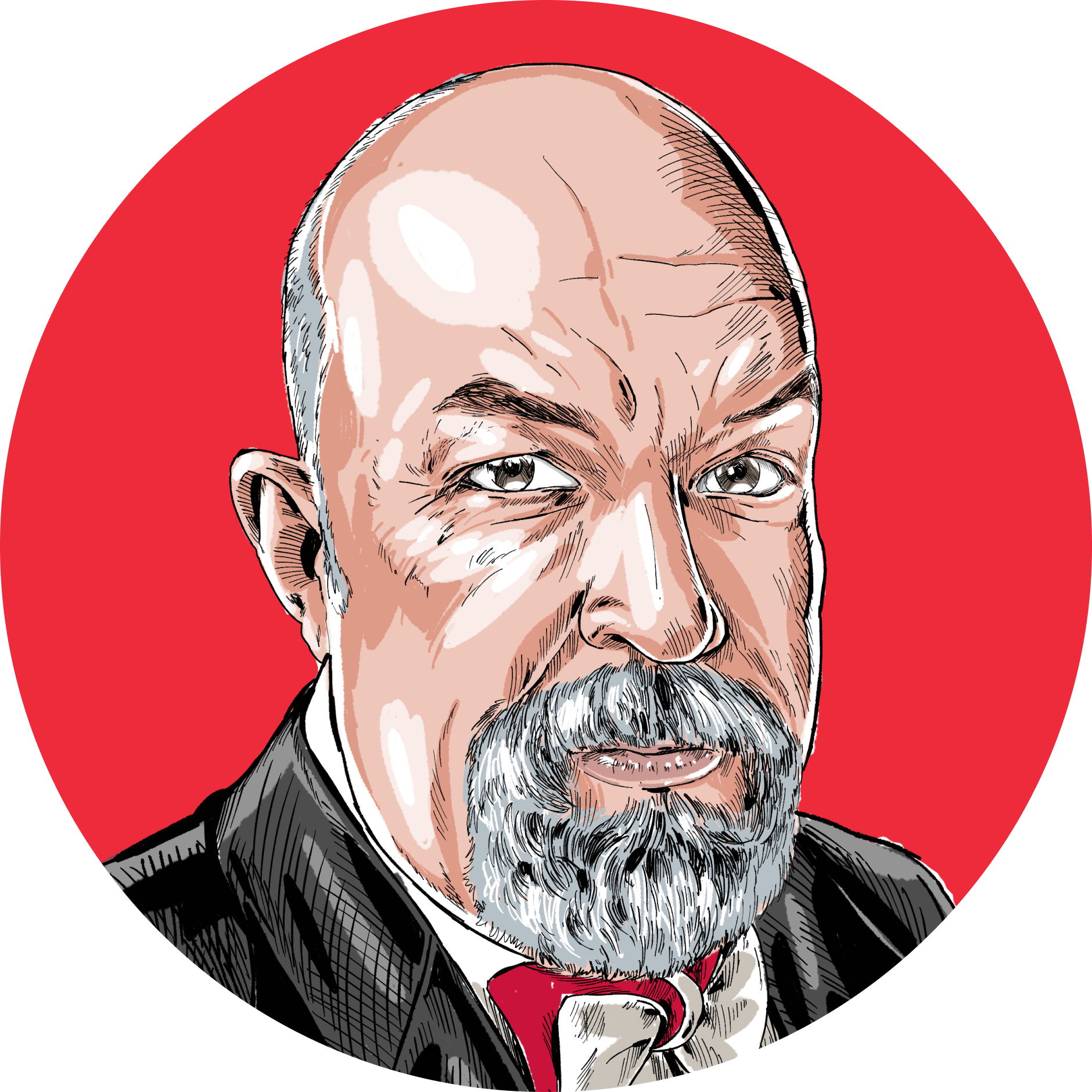Craig Deleeuw Robertson’s secret life wasn’t much of a secret.
Friends described the Utah man—shot to death in a confrontation with FBI agents who came to his house to arrest him for threatening to assassinate the president—as “a big teddy bear,” a regular churchgoer, all the usual stuff. People who knew him expressed “complete and total shock” at the violent final moments of his life.
Utah is a state with a lot of sand in it, and Robertson’s neighbors had their heads sunk well into it.
Robertson was already well known to both federal and local law-enforcement before his death in the early morning hours of August 9. Armed with an AR-style rifle, he had been involved in a “standoff”—as police put it—with Provo law enforcement in 2018 after threatening utility workers with a handgun. The workers, employed by Google Fiber, had knocked on his door to let him know they were going to work on a pole abutting his backyard; when he didn’t answer, they went to work. They had to finish the job under police protection. When Provo police arrived at his house, Robertson had upgraded from the handgun to a rifle. No charges were filed—Robertson was, in the view of the police, just another American “exercising his Second Amendment rights, albeit a little recklessly.”
You’d think that Robertson would have welcomed the Google Fiber work. Like every other Walter Mitty of the digital special forces, he lived his life online. In the real world, he was an overweight, partially disabled man in his mid-70s who didn’t get out much and needed a cane to walk. Online, he was always on the verge of something spectacular: “I hear Biden is coming to Utah,” he wrote two days before his death. “Digging out my old ghillie suit and cleaning the dust off the M24 sniper rifle. Welcome, buffoon-in-chief!” As is almost always the case with firearms fetishists of this kind, the gun talk was a big part of the point. The “M24 sniper rifle” he mentioned sounds pretty menacing; in reality, “M24 Sniper Weapons System” is just what the military used to call it when they stuck a Leupold scope on a Remington 700 hunting rifle. Every Elmer Fudd from sea to shining sea has a Remington 700 hunting rifle (it is the bestselling rifle of its kind in the United States)—but, oh, an “M24 sniper rifle”—now, you’re an operator!
Similarly phrased outbursts of equipment fetishism characterized Robertson’s other threats—and there were many of them—against public officials. E.g.:
Heading to New York to fulfill my dream of iradicating [sic] another of George Soros two-but [sic] political hach [sic] DAs. I’ll be waiting in the courthouse parking garage with my suppressed Smith & Wesson M&P 9mm to smoke a radical fool prosecutor that should never have been elected. I want to stand over Bragg and put a nice hole in his forehead with my 9mm and watch him twitch as a drop of blood oozes from the hole as his life ebbs away to hell!!
BYE, BYE, TO ANOTHER CORRUPT BASTARD!!!
The word “eradicating,” in various permutations and spellings, appears throughout Robertson’s œuvre. He liked to post pictures of firearms labeled “Democrat eradication tool” or “Merrick Garland eradication tool.”
Federal agents had been at Robertson’s house only a few days before the final confrontation. He told them to go away and come back with a warrant—which, eventually, they did. In the meantime, he taunted and threatened them online:
TO MY FRIENDS IN THE FEDERAL BUREAU OF IDIOTS: I KNOW YOU’RE READING THIS AND YOU HAVE NO IDEA HOW CLOSE YOUR AGENTS CAME TO ‘BANG.’”
In another variation, “bang” is “violent eradication.”
And then there’s this:
Hey FBI, you still monitoring my social media? Checking so I can be sure to have a loaded gun handy in case you drop by again.
According to the FBI, he did, in fact, have a loaded gun—a .357 revolver—that he pointed at agents before they shot him.
But, apparently, nobody in Robertson’s life saw this coming.
Except Trump Inc.
It was Donald Trump’s Truth Social, one of the platforms on which Robertson was active, that put him on the FBI’s radar, by reporting his earlier threat to New York prosecutor Alvin Bragg, who has brought one of the many criminal cases against the former president. Firms like Meta may be too big to effectively keep track of what’s happening on their platforms—Instagram has just seen another grisly murder livestreamed—but Truth Social, with its smaller user base, has a better idea of the kind of lunacy its service is incubating. It is a great place to caterwaul about how corrupt and Democrat-dominated the FBI is and how Trump is going to clean it up—right up until the point the Trump-owned platform rats you out to the FBI. You can see how it would look bad if a Trump guy had posted his fantasies about assassinating Joe Biden and Kamala Harris on a Trump-owned platform and then tried to go through with it. And so Trump Inc. dropped the dime.
It’s a funny old world.
There isn’t any doubt that Craig Deleeuw Robertson acted like a man who was trying to get himself killed by the FBI. There is some question about whether the FBI should have been so accommodating.
The FBI puts a great deal of emphasis on “de-escalation” training and techniques, and many knowledgeable people in law enforcement regard it as one of the best and most capable agencies in the world when it comes to hostage negotiations, arresting targeted individuals barricaded in their homes, ending armed standoffs, that kind of thing. But those procedures take hours or days to carry out—or much longer: As a young student journalist, I was at Waco for part of the 51-day standoff between federal agents and the cultists huddled in their little citadel.
“If they were utilizing their tactics properly, this could go on eight or nine hours,” says Roy G. Taylor, Ph.D., a litigation consultant who has served as chief of police in several departments and whose résumé includes a stint on the FBI Joint Terrorism Task Force. “The biggest thing is containment. You come into the neighborhood, remove people from the surrounding area, engage in conversations.” That goes on until it doesn’t. “If it appears there’s no resolution, it’s a standoff situation, it’s been a number of hours, you’ve learned about his mindset and intentions based on the conversations you’re having, constantly evaluating the situation, then you go to the decision-making model. What information do we have? What do we have lawful authority to do? What is our plan? How do we execute the plan?”
In the case of a suspect such as Robertson, there are competing considerations. For one thing, he was known to be armed and known to be willing to confront police while armed. On the other hand, he was a hobbled old man.
“You’d want to have less-than-lethal munitions handy,” Taylor says, “beanbag rounds, that kind of thing. Based on his age and his being frail, that probably would have been effective.”
But there were also the guns to think about. “You’d take his age and all into consideration,” Taylor continues. “But whether it is a 5-year-old or a 75-year-old, if he has enough physical dexterity to pull the trigger, they pose the same threat. Having the ideology he has expressed, his hatred toward the FBI, I would certainly take all those things into account in a threat assessment.”
The political context is also impossible to ignore.
“Would they have been that aggressive if the president wasn’t coming to town that day?” Taylor asks. “Probably not.”
Exactly how aggressive the FBI agents on the ground were is a matter of some interest. In comparison to the eight or nine hours of de-escalation protocols that might have been expected in another case, only a few minutes passed between FBI agents showing up on Robertson’s doorstep and their shooting him. At least, that’s the story as told in the FBI’s press release—the Salt Lake City field office did not respond to my questions about the case, and there’s a palpable sense that nobody really wants to talk about this.
But it seems that whatever happened, happened quickly. There might be a good explanation for that—if the agents had good reason to think Robertson was about to start shooting at them or in a position to harm someone else. But that is pretty iffy. Robertson was shot inside his house after a comedy of errors of sorts, in which agents tried to knock down his door with a battering ram but failed to—that must be some door. Instead of cordoning off the area and trying to talk Robertson into surrendering, the FBI drove a breaching vehicle through the exterior of his house and made a dramatic entrance. At that point, according to the FBI, Robertson pointed the .357 revolver at agents, who shot him to death in response. They dragged him out of the house and attempted to resuscitate him. His body remained on the sidewalk for almost two hours before being taken away.
Federal officials investigating the scene of the shooting were soon met by pro-Trump protesters bearing “F–k Joe Biden” signs.
And everybody is still pretending they didn’t see this coming.
A few days later, a Texas woman, 43-year-old Abigail Jo Shry of Alvin (about 30 miles outside of Houston) was arrested after threatening U.S. District Judge Tanya Chutkan, who is overseeing one of the criminal cases against Donald Trump being brought by special counsel Jack Smith. According to investigators, Shry left a voicemail for Chutkan, in which—after denouncing the judge as a “stupid slave” and a “n—-r”—declared:
You are in our sights, we want to kill you. … If Trump doesn’t get elected in 2024, we are coming to kill you, so tread lightly, b—h. … You will be targeted personally, publicly, your family, all of it.
Shry also is accused of threatening to murder Rep. Sheila Jackson Lee, who is a candidate for mayor of Houston, and other Democrats.
According to a federal affidavit in the case, “Shry stated that she had no plans to travel to Washington, D.C. or Houston to carry out anything she stated, adding that if Sheila Jackson Lee comes to Alvin, then we need to worry.”
Shry, arrested by agents with the Department of Homeland Security, apparently had the good sense not to meet the feds with a gun in her hand.
The modern period of paranoia and extremism on the American right does not begin with the Donald Trump campaign of 2016—it begins with the terrorist attacks of September 11, 2001. The history of the digital world, it is worth remembering, is very short: The 9/11 attacks came just seven years after the launch of the first commercial web browser, Netscape Navigator, and two years after the launch of Google’s Blogger. Extremist literature and conspiracy stories that once would have been limited to furtively distributed mimeographs and fringe-group fax lists were suddenly accessible to everybody—at just the wrong moment: The 2000 presidential campaign had been fought out in overtime and in effect settled by the Supreme Court, leading to a sense of political instability. Shortly thereafter, the 9/11 attacks injected trauma and a sense of domestic vulnerability into American politics, making them powerful factors in a way they hadn’t been since the Civil War.
In the wake of 9/11, the right side of the political spectrum was suddenly flooded with converts motivated not by supply-side economics or a collegiate reading of God and Man at Yale but by fear, dread, and hatred of: Them. (And just how easy it would be to replace one Them with another Them should have been obvious even then.) Right-leaning media, long dominated by such relatively staid print concerns as National Review (where I was a writer and editor for 15 years) and the Wall Street Journal opinion pages, had been suddenly expanded and invigorated by Dan Rather’s infamous attempt to derail the George W. Bush presidential campaign in the final hours of the 2004 election with fake documents purporting to show that his military service had been less than honorable. An entirely new media ecosystem was brought into existence by the organic, spontaneous, self-organizing project of debunking the Dan Rather smear.
Donald Trump, a longtime conspiracy-theory enthusiast, was perfectly positioned to exploit that new right-wing environment—and, when the time was ripe, he did. What had begun as citizen journalism quickly devolved into the imbecilic propaganda with which we are today familiar. Last week, for example, Fox News host Laura Ingraham complained that the Robertson case shows the feds adopting an attitude of “when in doubt, shoot first, ask questions later.” The police shooting of, say, black men in the suburbs of St. Louis not armed with a .357 Magnum has been received a little differently by the servile mouthholes over at Rupert Murdoch’s shop.
One of the great ironies is that a political tendency brought out of the shadows by Islamist jihadism has itself followed the same broad contours as its ur-enemy when it comes to recruitment and radicalization. Take this 2011 study of “lone wolf” Islamic terrorists, for example, which considers:
the question around the role of the internet as an incubator or accelerator of the Lone Wolf phenomenon. The internet is clearly the running theme between most of the plots included in this dataset and it appears to be a very effective tool: it provides a locus in which they can obtain radicalising material, training manuals and videos. It provides them with direct access to a community of like-minded individuals around the world with whom they can connect and in some cases can provide them with further instigation and direction to carry out activities. Many of the individuals in the dataset demonstrate some level of social alienation—within this context the community provided by the internet can act as a replacement social environment that they are unable to locate in the real world around them.
You could be talking about al-Qaeda there–or the readership of Breitbart.
A similar study of neo-Nazi self-radicalization finds “some of them really run riot, placing swastikas wherever they can … because they think they are acting in a completely extrajudicial space.”
(Both of the studies mentioned above are cited in this broader RAND report.)
But, of course, no space is entirely extrajudicial—threatening to assassinate the president or a judge is against the law whether the threat is shouted from a bullhorn, whispered with intent, or, as more often is the case, posted on Facebook or Truth Social or one of the other great sewers of American public life. It is illegal even if—as almost surely is the case with the two miscreants I am writing about here—there is no real underlying intent to carry out a murder.
If anything, it is an even more damning insight into our sick and sad society that threatening to murder public officials isn’t part of an actual plan of action but instead is, in effect, a creed, a statement of beliefs and values: “I am an American patriot, so the president must die, the judges must die, the senators must die, the cities must burn, my fellow Americans must be terrorized into fearful submission, they must fear and respect my suppressed Smith & Wesson M&P 9mm and—wait, how many characters does Twitter allow now?”
Robertson’s family put out a statement protesting that he was only exercising his First Amendment rights. Strange that these self-proclaimed patriots never know the first damned thing about the Constitution they claim to revere.
In Other News …
I am not sure which party should be demanding a correction. Some yokel on the internet called Don Surber writes:
[National Review] has a lengthy history of sneering at conservatives outside of Manhattan and Washington. In his infamous “The Father-Führer” screed, Yale grad [sic!] Kevin D. Williamson wrote, “So the gypsum business in Garbutt, New York, ain’t what it used to be. There is more to life in the 21st century than wallboard and cheap sentimentality about how the Man closed the factories down.”
The same author complains that National Review’s Mark Antonio Wright “carries on Williamson’s tradition of insipid resentment of conservatives who go mudding.” Well! I don’t know if Wright does a lot of mudding down there in Oklahoma, but I’ll bet that he got into plenty of mud working as a literal roughneck on an oil rig and in basic training—and I suppose being a officer in the Marine Corps Reserve makes one an elitist of some kind.
As for me, the general lack of liquid water in and around my native Lubbock, Texas, made mudding an impractical hobby. Is dusting a thing? In any case, I don’t think my old 1985 Mercury Topaz would have been up to it back in the day. These days, I do have a truck with pretty good off-road tires on it—have you seen the streets in these United States? If you want a testament to backward government priorities, there it is.
But what about “Rich Men North of Richmond”? I can’t think of the last time I’ve been asked so often about my view on a song.
A few thoughts:
First, Oliver Anthony has a terrific voice. I don’t mean in the sense that you might cast him in Aida—though, who knows?—but in the sense that his voice is suited to the kind of songs he sings. Of course he has technical limitations—so did Hank Williams, and that isn’t the point. (Technical excellence is more the exception than the rule among contemporary popular singers, especially among male singers.) He is a little like Mike Ness or Billy Gibbons: Not a lot of different arrows in the quiver, but he knows how to use them. (I once heard someone, I think it was Henry Rollins, describe Ozzy Osbourne as a man who built a palace out of timber most people couldn’t get a shack out of, or words to that effect.) And he is a better than fair guitar player, too—if that Gretsch resonator in the video (made in China, unless my eyes deceive me) is the instrument that is actually on the audio track, then he’s getting a better sound out of it than most people could. It’s a basic four-chord song (in B-flat, I believe), nicely done.
The pun in the title has been done before, and I suppose it isn’t even exactly a pun, Richmond being an Anglicization of the French “riche mont”—or “rich mountain.” People have been playing with the name Richmond for a long time—see, e.g., Ian McKellen and Richard Loncraine’s screenplay for Richard III, in which the titular king mocks the future King Henry VII, the Earl of Richmond, as “riche monde.” Some of Anthony’s writing is less economical than it could be—three lines where one would have done—and a little clumsy. Once the lightning-in-a-bottle effect fades, he might take some time to refine the song a little bit.
Oh, you want to know what I think about his politics?
Why? Why on Earth?
Short answer: Don’t care. Still don’t care. Not going to start caring.
Singer-songwriters aren’t at the very bottom of my list of entertainers whose political views interest me—the relevant bit of that hierarchy goes, in ascending order: film actor, stage actor, my dachshund, singer-songwriter—and there is a lot of entertainment I like with dopey politics embedded in it. Dopey doesn’t mean something I happen to disagree with. Bernard-Henri Levy has written a lot of things I disagree with, but he isn’t dopey; Bill Burr’s views on population, to take one subject he talks about a great deal, are dopey—hardly worth bothering to disagree with. He is funny, though—and that is what matters. He’s not delivering addresses to joint sessions of Congress, after all. I don’t think Chuck D. and I would agree on very much at all, but that doesn’t make “By the Time I Get to Arizona”—the politics of which are pretty dopey—any less fun to listen to.
Speaking of that great song, there isn’t that much daylight between Anthony’s views and Public Enemy’s, at least in places. Tell me you couldn’t work this into “Rich Men North of Richmond”:
’Cause my money’s spent on
The godd—n rent
Neither party is mine not the
Jackass or the elephant.
Oliver Anthony has written one song that has captured the imaginations of a few million people—and that is one song more than most people in his business ever find such success with.
Judging him on the relevant criterion—which is as a musician—then: Job well done.
Economics for English Majors
A reader gives me some grief about relying on nominal GDP per capita in an international comparison rather than citing PPP, or “purchasing-power parity.”
I do that for a reason.
The thing about poor countries is—they’re poor. Because their domestic economies consist of relatively poor people trying to sell things to other relatively poor people, many prices are lower. For example, it costs a lot less to hire a nanny or a housecleaner in India than it does in the United States. PPP, which is difficult to calculate, is supposed to give us a most realistic measure of cost of living. I am not sure that, as a conceptual matter, I believe it really does.
Take, for example, a domestic comparison of the sort we see very often: Sure, $200,000 a year is a lot of money if you live in Elkhart, Kansas, but it isn’t much if you live in Manhattan. It is true that you could rent an 800-square-foot apartment in Elkhart for a lot less than it would cost you in Tribeca—because there are a lot more people, including people with lots of money, who want to live in Tribeca instead of Elkhart. PPP might give you a better idea of dollars-per-square-foot, but it ignores where those square feet are. Put another way: A Manhattan apartment costs what it costs whether you come from Manhattan or from Elkhart, and an Elkhart apartment costs what it costs whether you come from Elkhart or Manhattan. You could say that a haircut is a haircut is a haircut, and there’s some truth to that, but common services that are part of everyday life reflect the fact that everyday life in London is different from everyday life in Tulsa.
You can get a real feel for this by looking at the extreme disconnects. Nominal GDP per capita and PPP GDP per capita for the United States are basically the same thing, because PPP is calculated by converting the other country’s currency into U.S. dollars and then buying the same basket of goods; there isn’t any conversion to do for the United States unless you are calculating PPP in some other currency, which I can’t remember ever having seen anybody do. (I am sure there is some obvious reason for some economists to do that, I just haven’t heard about it.) But South Sudan’s PPP GDP per capita is about five times its nominal GDP per capita—and switching from one measure to the other does not, in my view, make South Sudan five times more attractive a place to live. Switzerland’s PPP GDP per capita is only .84 its nominal GDP per capita—because it is really, really expensive to live there, reflecting the fact that the country is very attractive, particularly to affluent people. The well-off countries of Western Europe and Scandinavia have PPP-to-nominal ratios typically between 1 and 1.5. Very poor countries end up looking more like South Sudan, very rich countries more like Switzerland. It is an interesting comparison to look at, I think. A nifty data point that tells you something worth knowing.
That being written, I don’t doubt that PPP has its uses, but I am not sure that applying a poverty discount is as useful for understanding real standards of living as some people seem to think it is. If any of you economists out there think I am totally full of it please let me know, and I’ll revisit the question in the future.
Words About Words
I have to tell you, I was really curious about the use of the word privately in this context:
Privately as opposed to … what? In front of a cheering crowd in the Colosseum in Rome?
I believe that what was intended there was, “without fanfare or publicity,” in which case, good for her. In either case, congratulations.
About that Colosseum …
Colosseum sometimes is used to name a generic architectural category—there are “colosseums” all over the place, big outdoor amphitheaters in cities around the world. In that case, the word stadium is probably more correct. The big one in Rome was known by the Romans at the time as … something we don’t know, in fact. It is the Flavian Amphitheater and was called that by later writers in Latin (Amphitheatrum Flavium), but there apparently isn’t any evidence of its being called that at the time of its construction and first use. Colosseum, from the Latin colossus, is a word that probably became attached to the amphitheater because (as tradition holds) of a nearby colossal statue of Nero, depicted as a sun-god, the “Colossus Solis.” That was a bronze statue nearly 100 feet tall—colossal, indeed.
In any case, you had to be tuff to be in the Colosseum.
“Don’t you mean tough?”
No, tuff.
Tuff, from the Latin tophus, or stone, is a relatively malleable volcanic rock commonly used in construction in the ancient world, not only in the Greco-Roman world but far abroad: The famous Easter Island “moai” statues are made of tuff. It is tough stuff. Rocks that are partly (25 percent to 75 percent) composed of tuff are tuffaceous, as in tuffaceous sandstone.
Also from the Latin tophus are tophi, the little stone-like deposits in and around the joints that gout-sufferers have.
Also: Amphitheater is sometimes written Britishly, amphitheatre. It looks fancier that way. I am reminded that when the stadium the Rangers play in was renamed the Ballpark at Arlington, one observer remarked that he was surprised that efforts to fancy up the place hadn’t produced the “Ballparke” at Arlington. In any case, it currently goes by the much more pleasing name “Choctaw Stadium.” Its seating capacity is only a little bit less than that of the Colosseum in Rome.
Elsewhere
You can buy my most recent book, Big White Ghetto, here.
You can buy my other books here.
You can see my New York Post columns here.
In Closing
Tim Keller, the pastor associated with Redeemer Presbyterian Church in New York City, died of pancreatic cancer in May. He lived almost three years between his diagnosis and his death, which gave him time to think and write about his death, as well as to plan his own memorial service, which you can watch here. Those three years were, in spite of what I imagine was considerable suffering as a result of the cancer, a real gift to Keller. But every day is grace. Every one of them.









Please note that we at The Dispatch hold ourselves, our work, and our commenters to a higher standard than other places on the internet. We welcome comments that foster genuine debate or discussion—including comments critical of us or our work—but responses that include ad hominem attacks on fellow Dispatch members or are intended to stoke fear and anger may be moderated.
You are currently using a limited time guest pass and do not have access to commenting. Consider subscribing to join the conversation.
With your membership, you only have the ability to comment on The Morning Dispatch articles. Consider upgrading to join the conversation everywhere.